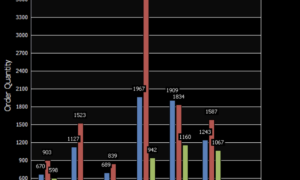For many enterprises still running on AS400/iSeries, reporting is a slow, manual, and error-prone process. Whether it’s sales summaries, inventory reports, financial closes, or production analytics – most teams still rely on manual data pulls, green screen navigation, or static printouts that are outdated the moment they’re printed.
In an age where businesses are demanding real-time insights, this reporting bottleneck not only slows decisions – it actively risks them being wrong.
This blog explores one of the most overlooked modernization opportunities in the AS400 world: automated reporting and dashboard enablement. We’ll break down the exact challenges, how RPA and GUI-layer reporting tools can solve them, and what kind of measurable gains can be unlocked in just a few months.
The Current State – AS400 Reporting by Manual Muscle
Despite being mission-critical systems, most IBM i environments do not support automated reporting workflows out-of-the-box. Here’s how reporting typically works in many mid-to-large enterprises:
- Business user requests a report.
- AS400 operator or admin logs into green screen.
- Navigates through multiple menus to run a batch job.
- Data is either:
- Printed to spool file and exported manually.
- Dumped into CSV with formatting issues.
- Copied manually into Excel for final presentation.
- Reports are then emailed or shared via internal drives.
This might work for 1–2 reports, once a week. But at scale, it becomes a daily operational time sink.
The Core Problems With Manual AS400 Reporting
| Problem | Real-World Impact |
| Delay in availability | Reports arrive hours (or days) late |
| Format inconsistency | Manual formatting leads to confusion |
| Error-prone exports | Users often miss filters or fields |
| Dependency on IT | Business users can’t self-serve |
| Outdated snapshots | Static data can’t support real-time decisions |
Let’s say a regional sales manager needs yesterday’s sales data by 9 AM to guide pricing decisions. On AS400, they’ll probably get it at noon – if someone’s available to run it.
A Specific Example – Daily Inventory Report Woes
The old workflow:
- Warehouse supervisors keyed in stock counts into AS400.
- Every morning, an operator pulled stock data from different screens and programs.
- Data was copied into Excel, merged manually, and formatted.
- Took ~2 hours per day, with regular errors in units and date ranges.
In the modern world, that’s 2 hours too late – especially when eCommerce, demand planning, and distribution decisions depend on it.
The Solution—Automated AS400 Reporting for the Modern Enterprise
Zero-code or low-code automated reporting from AS400, using a combination of:
- GUI wrappers that visualize green screen output in modern interfaces.
- RPA bots that extract, format, and send reports without human touch.
- Integration tools that sync AS400 data to BI tools like Power BI or Tableau.
Let’s see how this worked.
Step-by-Step: How AS400 Report Automation Was Deployed
Step 1: Identify Report Logic and Trigger
The inventory report was based on:
- Item ID
- Quantity on hand
- Warehouse location
- Date of last stock-in/out
Bot was programmed to trigger at 5:30 AM every day and log into the AS400 terminal emulator.
Step 2: Navigate and Extract Data
- The bot mimicked user keystrokes to access the inventory screen.
- Parsed structured data from each warehouse location.
- Combined data into a single table for processing.
Step 3: Apply Business Formatting
- Unit conversions were done automatically (e.g., box to SKU).
- Sorted by SKU, flagged low stock items.
- Converted output to Excel with company branding.
Step 4: Distribute Automatically
- Report emailed to 12 stakeholders including:
- Procurement
- Warehouse managers
- Inventory planner
- Uploaded to shared SharePoint location with time-stamped filename.
Step 5: Archive and Log
- Every run was logged with:
- Start time, end time, duration
- Success/failure status
- Auto-archive of reports for audit trail
Measurable Gains Delivered in 60 Days
| Metric | Before Automation | After |
| Time to generate report | 2 hours | 7 minutes |
| Error rate in reports | 9% | 0.3% |
| FTEs involved | 2 | 0 |
| Stakeholder satisfaction | 6.1/10 | 9.2/10 |
| Time to decision | Delayed by half-day | Made before market opens |
The Bigger Picture – How Reporting Modernization Unlocks ROI
Modernizing AS400 reporting doesn’t just eliminate manual effort – it creates a foundation for agile, data-driven operations, enabling:
- Real-time dashboards instead of static PDFs
- Self-serve reporting for business teams
- Integration with analytics tools for predictive modeling
- Elimination of dependency on specific personnel
This is where GUI modernization and RPA intersect for maximum transformation value – l without touching core business logic.
Also read: How to Transform Your AS400 Green Screen into a Modern GUI in 2025
Tools That Can Help Modernize AS400 Reporting
Here are a few platforms and methods Nalashaa recommends, depending on your stack:
1. Profound UI or Newlook
- Wrap green screens with modern UI
- Export data in usable formats
2. RPA Platforms (UiPath, Automation Anywhere)
- Bot-driven report extraction and formatting
- No code change in AS400
3. Middleware Integration
- JDBC/ODBC connectors to expose IBM i data to BI tools
4. Custom Portals
- Build lightweight front-ends for users to view reports and dashboards via web interface
What’s the Best Time to Start? Yesterday. But Now Works Too.
If any of these apply, you’re sitting on a goldmine of optimization:
- Users spend hours building recurring reports
- Reports differ each time due to formatting errors
- Business waits for IT every time they need data
- Decisions get delayed due to outdated info
- You’re doing AS400 GUI modernization and want quick wins
Starting with report automation gives you fast ROI, measurable impact, and momentum for deeper modernization.
Conclusion: AS400 Isn’t Holding You Back – Your Reports Are
Your IBM i system is powerful – but when your reports are still being run like it’s 1992, your business can’t move at 2025 speed.
Modernizing your AS400 reports is the lowest-effort, highest-visibility modernization initiative you can run – delivering results in days, not years.
Read More From Techbullion



































